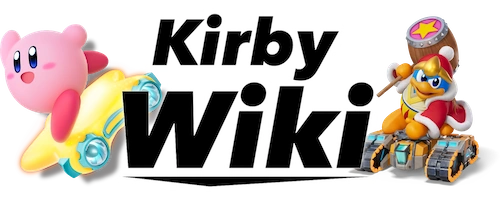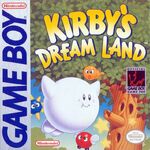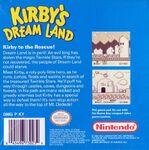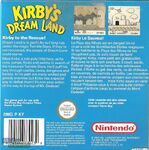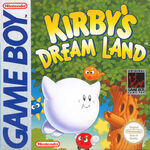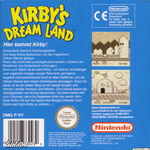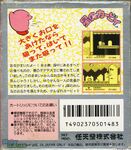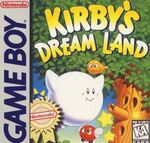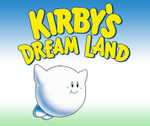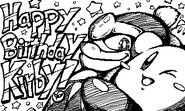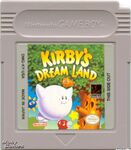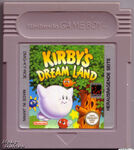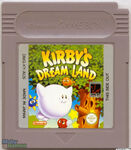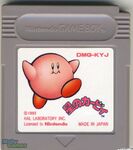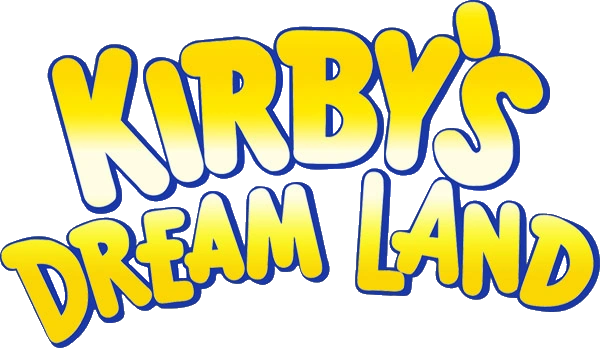| “ | The simplicity of Kirby's inhale/spit attack and Kirby's ability to fly over obstacles made this a perfect game for beginners. It introduced many of the enemies and power-ups that are now so familiar to Kirby's fans. It also introduced a character who would often be Kirby's star opponent: King Dedede!” |
| — Summary • Kirby's Dream Collection: Special Edition |
Kirby's Dream Land, known in Japan as 星のカービィ (Hoshi no Kābī, meaning Kirby of the Stars), is a platformer Kirby game for the Game Boy that was originally released in Japan on April 27, 1992, and was then later released on August 1, 1992 in North America and on August 3, 1992 in Europe.
The game is notable for being the first installment in the Kirby series. It was followed by two direct sequels, Kirby's Dream Land 2 and Kirby's Dream Land 3; it was then followed by Kirby 64: The Crystal Shards. These four games constitute the Kirby's Dream Land saga.
Story
King Dedede and his followers have stolen all of Dream Land's food as well as the Sparkling Star used to harvest them. Kirby sets off to reclaim both the food and the Sparkling Stars and teach the king a lesson.
Gameplay
Kirby's Dream Land operates similarly to other platformers during the 8-bit and 16-bit era of video games: Kirby must head toward the goal at the end of each level while jumping over obstacles and defeating enemies. Kirby can also fly but cannot leave the screen through doing so.
Like most games in the 80s and early 90s the player can accumulate points as they defeat enemies and collect items. The player is rewarded an extra life by means of gathering enough points. However, the game lacks a save function so scores are not recorded.
All levels are played on a two dimensional plane, allowing the player to move only left, right, up, and down.
Kirby's main technique is his ability to inhale his opponents and items. When Kirby inhales an enemy or object, it remains in his mouth. At this point, Kirby can either spit it out like a projectile in the form of a star that causes damage to anything in its path, or simply swallow it and defeat it altogether. When food is inhaled, it is swallowed right away and will heal Kirby if he has any damage. The concept of flying and eating in a platformer was new at the time.
Unlike in future games, Kirby does not gain new powers upon swallowing enemies that hold them. However, Spicy Curry and Mint Leaves can be found throughout the game, allowing Kirby to spit fireballs and air puffs respectively for a short time.
Levels
Green Greens
| Main article: Green Greens |
The first level in the game, Green Greens is a land with big grasslands and forests. Green Greens appears in Kirby Super Star, in Spring Breeze, a possible remake.
- Mid-boss: Poppy Bros. Sr.
- Boss: Whispy Woods
Castle Lololo
| Main article: Castle Lololo |
A haunted castle owned by Lololo, who is based off the main character in HAL Laboratory's Adventures of Lolo series.
- Mid-boss: Lololo
- Boss: Lololo & Lalala
Float Islands
| Main article: Float Islands |
A chain of small tropical islands, including dark caverns and a pirate ship.
- Mid-boss: None
- Boss: Kaboola
Bubbly Clouds
| Main article: Bubbly Clouds |
A level taking place high above the clouds.
- Mid-boss: Kracko Jr.
- Boss: Kracko
Mt. Dedede
| Main article: Mt. Dedede |
The final level is inside King Dedede's castle on the top of a tall mountain. Kirby has to fight all of the game's previous bosses again, each time going through rooms based on the stage the boss first appeared in before he can fight King Dedede.
- Mid-bosses: Previous stage bosses (mid-bosses are excluded.)
- Boss: King Dedede
Modes
If the player presses the up, A, and select buttons at the title screen, the Extra Game becomes available. The Extra Game has exactly the same story and levels as the main game, but enemies and bosses have become more powerful.
If the down, B, and select buttons are pressed on the title screen, 'Config Mode' can be accessed, allowing the player to choose how much vitality and lives Kirby will start with when the game begins, or to listen to the game's music and sound effects.
Legacy
Kirby's Dream Land is the first game in the Kirby franchise, introducing characters and ideas that would appear in future installments. Two sequels, Kirby's Dream Land 2 and Kirby's Dream Land 3 were made for the Game Boy and Super Nintendo, respectively.
In addition to being the first game, there are strong references to it as later games come. Stage 7-6 of Kirby's Adventure (and its remake) is completely based on the levels of Kirby's Dream Land, complete with monochrome graphics and the music from Green Greens.
In Kirby Super Star (and its remake), one sub-game is based on Kirby's Dream Land called Spring Breeze. It retains the same plot and gameplay from the original, but graphics and sounds are enhanced, and Copy Abilities are included. However, Castle Lololo is removed, and Lololo & Lalala are now the bosses of Float Islands, Kaboola is removed altogether as well. Kirby also no longer fights the previous stage bosses in Mt. Dedede.
In Kirby Super Star Ultra, a harder version of Spring Breeze called Revenge of the King is included which acts quite like the Extra Game of Kirby's Dream Land. Many of the enemies from the original Extra Game are included, and Kaboola returns as Kabula.
Kirby's Dream Land has also been re-released on the 3DS Virtual Console.
Characters
| The following section contains transcluded content from the Database. Source: (view • edit • help) |
Bosses
Whispy Woods | Lololo and Lalala | Kaboola | Kracko | King Dedede
Mid-Bosses
Poppy Bros. Sr. | Lololo | Kracko Jr.
Enemies
Benny | Blatzy | Blipper | Blopper | Booler | Boomer | Bronto Burt | Broom Hatter | Cappy | Cawcun | Chuckie | Coner | Dizzy | Flapper | Flotzo | Gaspar | Glunk | Gordo | Grizzo | Grumples | Hurly | Kabu | Kookler | Koozer | Mr. P. Umpkin | Mumbies | Parasol | Peezer | Poppy Bros. Jr. | Puffy | Scarfy | Shotzo | Sir Kibble | Skuller | Squishy | Tookey | Twizzy | Two Face | Waddle Dee | Waddle Doo | Whiskers | Wizzer
Music
| Main article: Kirby's Dream Land/Music |
Reception
Kirby's Dream Land has received mostly positive reviews, holding an average of 62.22% at Game Rankings based on 9 reviews.[5] Nintendo Power editors George and Bob shared roughly similar opinions of the game. George stated that 'it is a really fun game, owing its quality to its excellent play control and well thought out concept', while Bob stated that 'it is deceptively simple looking, when it in fact features a decent challenge for more experienced gamers'. In an article detailing various Kirby series video games, IGN stated that it 'was a decent platformer, but also very basic compared to later titles'. They also listed it as one of the games they wanted to be re-released for a hypothetical "DSi Virtual Console" service on the Nintendo DSi's DSiWare, describing it as a "replayable classic adventure." They also added that original characters like Kirby were the stars of the Game Boy rather than established characters such as Link, Mario, Samus Aran, and Pit. They would again praise Kirby's Dream Land for being an original game in their "History of the Game Boy" article, adding that while "attitude" was common in new platforming mascots, Kirby was cheery and adorable, while the game featured "breezy, casual gameplay and lighthearted atmosphere." 1UP.com praised it for its unique platforming mechanics, describing it as the start of a "gluttonous legend." Nintendojo described it as being an 'enriching experience', as well as being challenging. Nintendo Life stated that, while it was a quality game when it was first released, it has since been outclassed by followup titles in the series.
Kirby's Dream Land is also the best selling game in the Kirby series' history to date, selling over 5 million units worldwide.[6] Other than games in the Pokémon, Mario, and Tetris series, it was also the best selling game for the original Game Boy.
Trivia
- The cover art of the North American version of Kirby's Dream Land depicts Kirby as white instead of pink. This is because, at the time of the game's release, there was an argument going on between Masahiro Sakurai and Shigeru Miyamoto over Kirby's coloration. No decision had been reached by the time localization began so Nintendo of America, confused, chose the coloration that appeared on the Game Boy screen.
- This caused many fans to speculate that Kirby was some sort of friendly spirit.
- If the player pauses the game and waits 20 seconds, Kirby will begin dancing. After the dance is over, he will return to his original pose and remain idle until the game is unpaused.
- In the special Extra Mode credits showing the names of enemies, some of the names are absent, misplaced or misspelled.
- If Kirby's Dream Land is played on a Game Boy Advance SP, the player is able to switch the color palettes of the game, using the +Control Pad and the A and B buttons. One combination is Left and B, which switches the game to its original black and white color.
- Kirby's Dream Land was spelled incorrectly on Club Nintendo's website; it is spelled Kirby's Dreamland.
- Despite King Dedede's frequent appearance as an antagonist in the series (often portrayed as Kirby's "arch nemesis"), Kirby's Dream Land is the only title in which King Dedede is actually the real final boss.
- Kirby's Dream Land and Kirby and the Rainbow Curse are the only platformers in the series that are devoid of icy stages.
- In the Music Room in Kirby and the Rainbow Curse, Kirby's Dream Land is represented by a monochromatic image of Kirby riding the Warp Star.
- The Japanese commercial for Kirby's Dream Land features a child drawing a picture of Kirby while singing a song about the process. This sequence would later be recreated in the opening of Kirby's Adventure.
